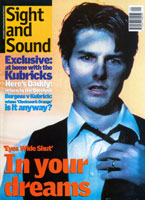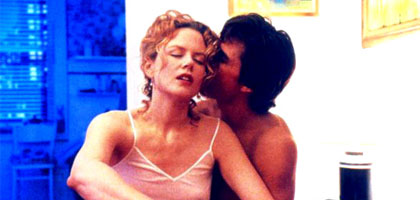Primary navigation


Surprisinlgy staid, Kubrick's last film is more interested in fidelity - that of its central couple and that of the film to its source book. Review by Charles Whitehouse
The dream interpreter is a kind of detective, and given the orgy of opinion about Eyes Wide Shut currently being enjoyed, let's use the detective's dictum and stick to the facts. The most shocking aspect of Eyes Wide Shut is not its long-anticipated sex scenes, but its fidelity to literature. No one expected such a faithful plot adaptation of Arthur Schnitzler's Dream Novel (Schnitzler was a friend of Freud's)
Kubrick and screenwriter Frederic Raphael have changed the story's setting from fin de siècle Vienna to present-day New York and added two major scenes. The first, near the beginning, is at a black-tie party where Tom Cruise's Dr William Harford gets his pal Ziegler (Sydney Pollack) out of a sticky situation with a naked girl in a drug coma. The second is near the end, where a pool-playing Ziegler explains (or seems to) the fate of an anonymous woman who sacrificed herself for Harford when he was caught trespassing at a private orgy. Otherwise, the film strictly follows Schnitzler's curve: Harford is a man so jealous of a phantom - a naval officer his wife Alice (Nicole Kidman) confesses she was once passingly captivated by - that he can't go home again until he has committed some sort of sexual revenge.
But Cruise's Harford is an ineffective sexual adventurer. Presented with a queue of obliging fantasy women - a needy patient's daughter, a nice prostitute, an underage shopkeeper's daughter, a perfect-bodied masked orgygoer - he falters at consummation every time. While Alice mutters orgasmically to the pillowslips at home, Harford is cold and faithful: his revenge remains uneaten. Given that the new scenes stress his close male friendship with Ziegler, one wonders what became of Raphael's take on Kubrick's theme in his book Eyes Wide Open: "What he [Kubrick] wants is the naked woman at the refrigerator door as she remembers to put the chicken away before she goes to bed."
Eyes Wide Shut certainly starts with a bare-assed Kidman getting dressed, and the best example of what Raphael means comes shortly after, when Kidman's Alice is sitting on the toilet in her party frock. She flushes the toilet and asks Harford, "How do I look?" "Great," he answers without turning round. The viewer is meant to enjoy the witty combination of female allure and domestic banality, though Harford does not. He will only see Alice sexualised as another's lover. That ironic split between Harford's viewpoint and ours also applies to the way we see the other women as they make themselves available to him.
So while Harford's moral probity (his ethical foreign policy) seems admirable, we the voyeurs are assumed not to be party to it. A couple of suspicions are aroused: is it that Kubrick's mordant humour can't resist a dig in the ribs every time we see a naked woman, or is he visiting implicit judgement on current inferior moral standards? Neither feels right. Kubrick's films are famed for their distanced-but-intimate point of view, but here the viewer's is set dead against the protagonist's from the start - something of a radical move, and one that eventually proves decisive.
The casting of Cruise and Kidman complicates matters. It helps the balance of the film that Kidman, rarely present on screen after the opening half hour, gives the more raw and powerful performance, while the permanently on-screen Cruise remains on 'cruise control', enhancing the film's 'dream logic' with his passivity. But it is Cruise who has the burden of the dream. He tries to bring the intensity he won in Born on the Fourth of July to it - staring and shaking his head in awed disbelief a lot - but too near the surface is the keen boy charmer just itching to show us his somersault, and there's no physical disability here to make that eagerness poignant. While the public face of this real-life couple lends itself to the fictional New York marrieds and makes at least their routine togetherness feel natural, it likewise deepens the gulf between what we and Harford are supposed to be feeling when we see the same things.
As soon as Harford leaves home to visit a grieving girl - his first opportunity to cheat on Alice - Raphael's "eroticism of monogamy" theme is discarded. We are then forced to mimic Harford's fierce gaze as he surveys further heterosexual options to his sullied marriage. It's only then that Kubrick's strategy becomes clear: we the viewers experience Harford's will-he-won't-he dilemma as if we were wearing him as a mask. Our status as real spectators to Harford's pallid misfortune has no cathartic dimension.
In that sense, Eyes Wide Shut feels like a 70s Buñuel film, depending for its strangeness on enigmatic behaviour in formal surroundings. The film is resolutely old-fashioned whenever illicit sexual contact begins: just as the deliberately clichéd dialogue between Alice and a Hungarian seducer at Ziegler's party reminds one irresistibly of the Ferrero Rochét adverts, so the mask-and-robe orgy, with its ponderous Gothic touches and echoes of L'Histoire d'O, feels like a stolid throwback to the more innocent times of Hammer horror or Roger Corman's Poe movies. The problem with setting such an orgy in modern New York is that contemporary audiences know what sexual extremes are really on offer there and how tame by comparison are the sculptural entanglements on offer here. Against this fact we have the commercial reality of a Cruise and Kidman movie needing an 'R' rating in the US, which has forced digital concealment of sexual thrusting on US release prints of a Stanley Kubrick movie.
Yet there's more to the dated feel of this movie than its crucifixion on the cross of movie-business double standards. Not only does it look visually modest in the age of The Matrix (a first for a Kubrick film), it's also dated in its fidelity to the mid-century ideal of the European art movie. Such a work, it assumes, should have a painstaking exposition that requires intellectual engagement by the audience - few people's idea of a Tom Cruise movie. The path through its philosophical maze concerns the destructive nature of truth-telling between intimates. (My guess is that the phrase "Eyes Wide Shut" is shorthand for the most successful attitude a monogamous couple can adopt to viewing each other's inner life.) However, the trail keeps disappearing, lost to a more sweeping concern about the nature of our responsibility to all other humans for their safety - the doctor's dilemma, and Kubrick was of course a doctor's son.
Suppose, then, we presume that Stanley Kubrick was a little out of touch at the end of his life and that his need to shoot New York in England found him sleepifying the bustling metropolis, making it more fuzzily soft like Dream Novel's Vienna? Perhaps he was dreaming of skating in Ophuls' dizzying La Ronde tracks (another Schnitzler tale) and didn't care so much where he was meant to be? Or perhaps Raphael is just too fusty a writer? Or is it that Kubrick knew that the fantasies of those who retire from the singles arena are often by their nature somewhat staid, that the very lack of imagination is what makes them both exciting and comforting? Eyes Wide Shut is no masterpiece, but it is endlessly fascinating.